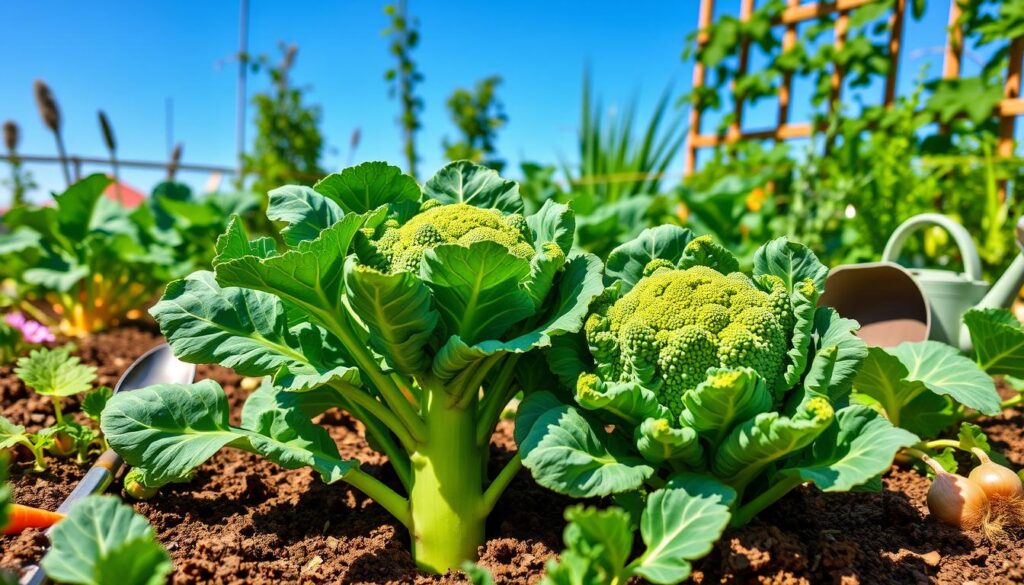Learning to grow broccoli is fun and rewarding. It gives you a steady supply of this healthy veggie. With a good guide, you’ll enjoy every step, from planting to harvesting. Broccoli is packed with vitamins, minerals, and antioxidants.
Broccoli is great for a healthy diet. Anyone can grow it like a pro with the right guide. Whether you’re new to gardening or experienced, growing broccoli is a valuable skill. Follow expert tips to ensure a successful harvest and enjoy your home-grown broccoli.
With the right knowledge and tools, you can grow broccoli like a pro. You’ll learn from the basics to advanced tips. A detailed guide will help you overcome challenges and succeed in gardening.
Introduction to Broccoli Growing
Before starting with broccoli, it’s key to create the right growing environment. This includes soil prep, watering, and fertilizing. Follow expert tips and a good guide to ensure success and a bountiful harvest.
Key Takeaways
- Learning how to grow broccoli can be a fun and rewarding experience
- A broccoli growing guide is essential for creating an ideal environment for growth
- Understanding broccoli planting tips is critical for a successful harvest
- Broccoli is a great addition to a healthy diet, rich in vitamins, minerals, and antioxidants
- With the right knowledge and tools, anyone can become a proficient broccoli grower
- A detailed broccoli growing guide can help overcome common challenges and achieve success
Understanding Broccoli Varieties and Their Growing Requirements
Knowing the different broccoli varieties and their needs is key to a good harvest. A good guide should cover popular types, climate needs, and soil preferences. By following the right conditions and care, gardeners can grow healthy broccoli and enjoy a big harvest.
Popular broccoli types include ‘Deep Purple’, ‘Waltham 29’, and ‘Packman’. Each has its own look, growth pattern, and time to mature. For instance, ‘Deep Purple’ likes cool weather, well-draining soil, and full sun. ‘Waltham 29’ can handle heat better and grows well in many soils.
Popular Broccoli Cultivars
- ‘Deep Purple’: A cool-season crop with deep purple florets and a sweet, mild flavor
- ‘Waltham 29’: A versatile variety that can thrive in a range of climates and soil types
- ‘Packman’: A high-yielding variety with large, green florets and a compact growth habit
Climate Requirements
Broccoli loves cooler weather and well-draining soil. It grows best in mild winters and cool, moist summers. Planting in early spring or late summer provides the best conditions.
Soil Preferences
Broccoli prefers soil with a pH of 6.0 to 7.0 and lots of nutrients. A mix of compost and organic matter in well-draining soil is ideal. Following proper care and soil conditions leads to a healthy broccoli crop.
| Soil Type | pH Range | Nutrient Requirements |
|---|---|---|
| Clay | 6.0-6.5 | High in organic matter |
| Sandy | 6.5-7.0 | Low in organic matter |
| Loam | 6.0-7.0 | Balanced nutrient levels |
Best Times to Plant Broccoli in Different Regions
When growing broccoli at home, knowing when to plant is key. Broccoli planting tips stress the need to think about your area’s climate and frost dates. Broccoli loves cooler weather, making spring or fall the best times to plant.
For spring, start broccoli indoors 4-6 weeks before the last frost. Then, move it outside. For fall, sow seeds in late summer to early fall, 8 weeks before the first frost. This way, broccoli matures before winter.
Some important tips for organic broccoli cultivation include:
- Check your area’s average frost dates
- Pick a broccoli variety that fits your region and planting time
- Make the soil fertile and well-draining with organic matter
By following these broccoli planting tips and considering your region’s needs, you can grow delicious broccoli at home.
Growing broccoli at home can be rewarding. It’s great for both experienced gardeners and beginners. Organic broccoli cultivation lets you grow fresh, healthy food for your family.
| Region | Best Time to Plant |
|---|---|
| Northern States | Early spring or late summer |
| Southern States | Late summer or early fall |
| Coastal Areas | Year-round, with careful planning |
Selecting and Preparing Your Garden Space
Growing broccoli at home starts with the right garden space. You need well-draining, fertile soil with a pH between 6.0 and 7.0. Testing your soil and making adjustments is key, following the care instructions for broccoli.
Soil Testing and Amendment
Soil testing shows the pH and nutrient levels. Based on the test, add compost or manure to improve the soil. This makes your broccoli plants thrive, as a growing guide suggests.
Garden Bed Layout
Plan your garden beds for the broccoli’s mature size. Leave enough space for air to prevent disease. If space is tight, use large containers with good drainage.
Container Growing Options
Container growing lets you control the soil and nutrients. Choose containers with good drainage and at least 6-8 inches deep. This way, you can enjoy a rich harvest of broccoli, whether in a garden bed or containers.
Essential Tools and Materials for Growing Broccoli
To start growing broccoli, you need the right tools and materials. For organic broccoli, you’ll need quality seeds, good potting soil, and organic fertilizers. You’ll also need basic gardening tools like a trowel, watering can, and gloves.
Having the right materials is key for broccoli care. Here are the essential items:
- Broccoli seeds: Choose high-quality seeds for organic growth.
- Potting soil: Pick a soil that drains well and is nutrient-rich.
- Organic fertilizers: Use chemical-free fertilizers for healthy growth.
- Gardening tools: Get a trowel, watering can, and gloves for easier care.
You might also need containers, trellises, or row covers for your broccoli. With the right tools and a good guide, you can have a successful harvest. Enjoy the benefits of growing organic broccoli.
Always follow proper care instructions and use the right materials. This will help your broccoli grow well and give you a great harvest.
| Tool/Material | Description |
|---|---|
| Broccoli seeds | High-quality seeds for organic broccoli cultivation |
| Potting soil | Well-draining potting soil rich in nutrients |
| Organic fertilizers | Chemical-free fertilizers for healthy broccoli growth |
| Gardening tools | Basic tools like trowel, watering can, and gardening gloves |
How to Grow Broccoli from Seeds to Seedlings
To grow broccoli from seeds to seedlings, you need to pay close attention. Start by sowing seeds in seed trays or small pots. Keep the soil warm and moist until the seeds germinate. This step is key for growing healthy broccoli at home.
When seedlings have 2-3 sets of leaves, it’s time to move them up. Transplant them into bigger pots or directly into the garden. Make sure they get enough light, keep the soil moist, and fertilize lightly. Following these care tips will help your seedlings thrive.
Indoor Seed Starting Methods
- Use seed trays or small pots with a warm and moist soil mixture
- Provide adequate light, such as grow lights or a sunny windowsill
- Maintain consistent moisture and fertilize lightly
Proper Seedling Care
Before moving seedlings outside, harden them off first. This means gradually exposing them to outdoor conditions over 7-10 days. By following these tips, you’ll grow healthy broccoli plants at home.
Transplanting Techniques for Healthy Growth
When growing broccoli at home, transplanting is key. It needs careful attention to ensure healthy growth. You must provide the best conditions for broccoli, like enough sunlight, water, and nutrients.
By following the right broccoli care instructions, you can avoid transplant shock. This helps your broccoli grow strong and healthy.
Here are some tips for a successful transplant:
- Handle the roots with care to avoid damaging them
- Harden off the seedlings before transplanting to acclimate them to outdoor conditions
- Transplant in the cooler part of the day to reduce stress
- Keep the soil consistently moist in the first few days after transplanting
By following these tips and providing the right conditions, your broccoli will thrive. Make sure to research the specific needs of your broccoli variety. This ensures you give it the best care.
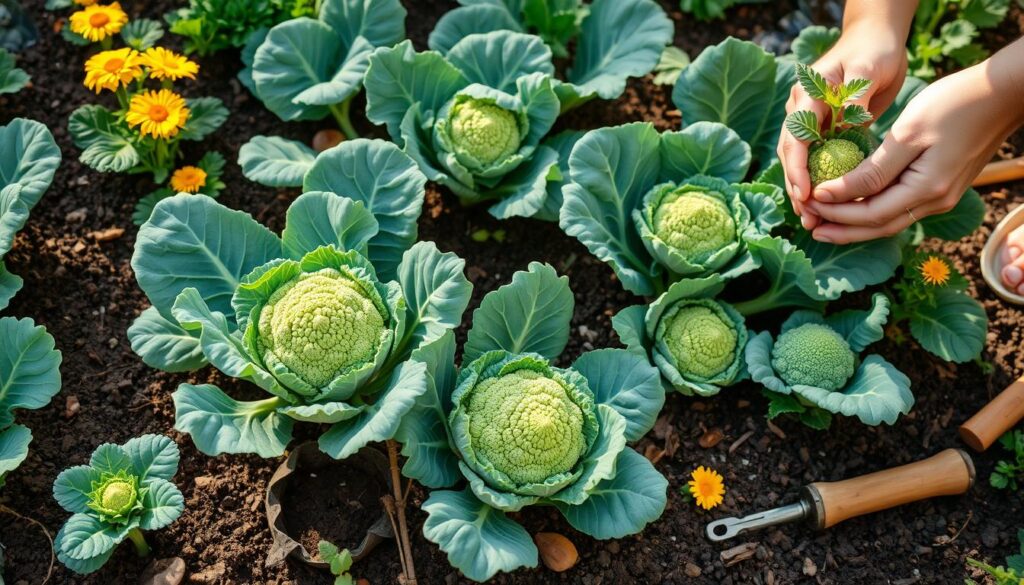
With the right transplanting techniques and broccoli care instructions, you’ll grow delicious and healthy broccoli at home.
| Transplanting Tips | Benefits |
|---|---|
| Handle roots with care | Reduces transplant shock |
| Harden off seedlings | Acclimates seedlings to outdoor conditions |
| Transplant in cooler part of day | Reduces stress on seedlings |
Watering and Fertilization Guidelines
Proper watering and fertilization are key for broccoli’s health. Knowing how much water broccoli needs is important. Broccoli plants need steady moisture, most when they’re young. As they grow, they need about 1-2 inches of water each week.
For organic broccoli care, natural fertilizers are a good choice. Options like compost, manure, and fish emulsion are great. They give broccoli the nutrients it needs to grow well. A guide will suggest when to feed your broccoli to avoid too much fertilizer.
Water Requirements Through Growth Stages
- Seedlings: consistent moisture
- Mature plants: 1-2 inches of water per week
Organic Fertilizer Options
Some top organic fertilizers for broccoli are:
- Compost
- Manure
- Fish emulsion
Feeding Schedule
Having a good feeding schedule is vital for broccoli’s growth. By following a guide and using organic fertilizers, you can create a schedule that fits your plants’ needs.
Managing Pests and Diseases
When growing broccoli, knowing about pests and diseases is key. Organic methods are best for managing these issues. They help keep your broccoli healthy and strong.
Aphids, cabbage worms, and flea beetles can harm your broccoli. Use neem oil, row covers, and hand-picking to fight them. Also, keep the soil healthy and air flowing to avoid diseases like club root and downy mildew.
Here are some tips to prevent problems:
- Choose broccoli varieties that resist pests and diseases
- Keep your garden clean and free of debris
- Use companion planting to keep pests away
By following these tips and using organic methods, you can keep your broccoli plants healthy. Always refer to a detailed broccoli growing guide and care instructions for the best results.
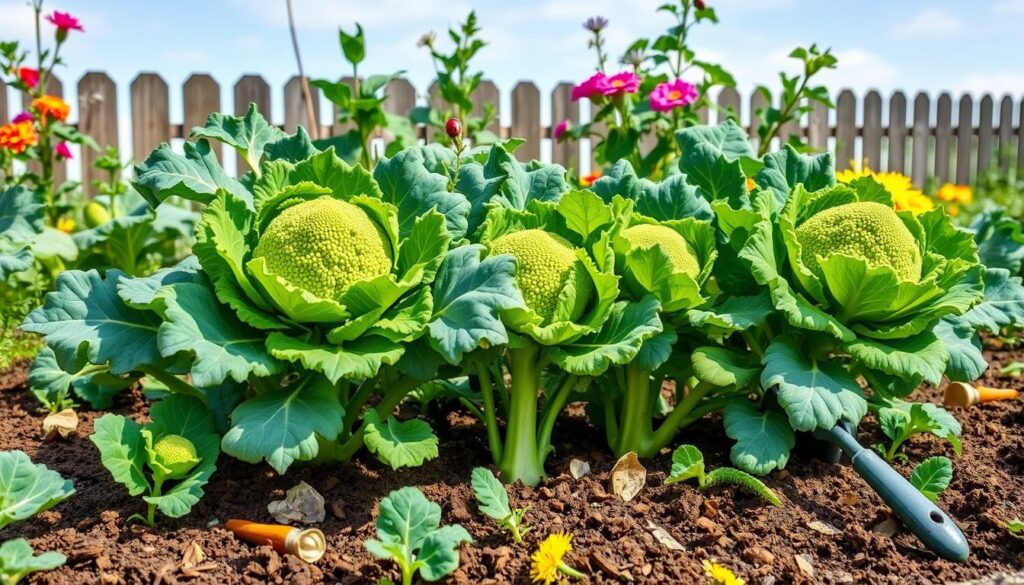
Companion Planting Strategies for Broccoli
When growing broccoli at home, think about companion planting. This method pairs different plants to boost growth, taste, and pest defense. For organic broccoli, this approach helps keep your garden healthy and balanced. By picking the right companions, your broccoli will thrive.
Herbs like basil and dill are great for broccoli. They make the broccoli taste better and keep pests away. Carrots and beets are also good, as they loosen the soil and make it better for plants. But, avoid plants like those in the Brassica family, as they can get sick too.
Best Plant Companions
- Basil: repels pests and improves flavor
- Dill: improves growth and repels aphids
- Carrots: breaks up compacted soil and improves soil structure
- Beets: adds nutrients to the soil and improves its structure
Plants to Avoid
- Members of the Brassica family: susceptible to the same diseases
- Plants that shade the broccoli or compete for water and nutrients
Companion planting makes your garden more diverse and strong. It’s key for growing broccoli well at home. Just remember to pick the right friends for your broccoli to grow well.
| Companion Plant | Benefits |
|---|---|
| Basil | Repels pests, improves flavor |
| Dill | Improves growth, repels aphids |
| Carrots | Breaks up compacted soil, improves soil structure |
When and How to Harvest Your Broccoli
Knowing when to harvest broccoli is key for its taste and texture. Look for tight, green buds and a firm crown. This is essential for broccoli care, as it affects the quality of your harvest. A good guide will stress the importance of harvesting correctly.
It’s easy to tell when broccoli is ready. Cut the main head with a sharp knife, leaving a bit of stem. This helps the plant grow more side shoots. You can keep picking these, making the plant produce more.
- Check the buds regularly to determine the best broccoli harvest timing.
- Use a sharp knife to cut the main head, leaving a small portion of the stem attached.
- Harvest side shoots continuously to encourage the plant to produce more.
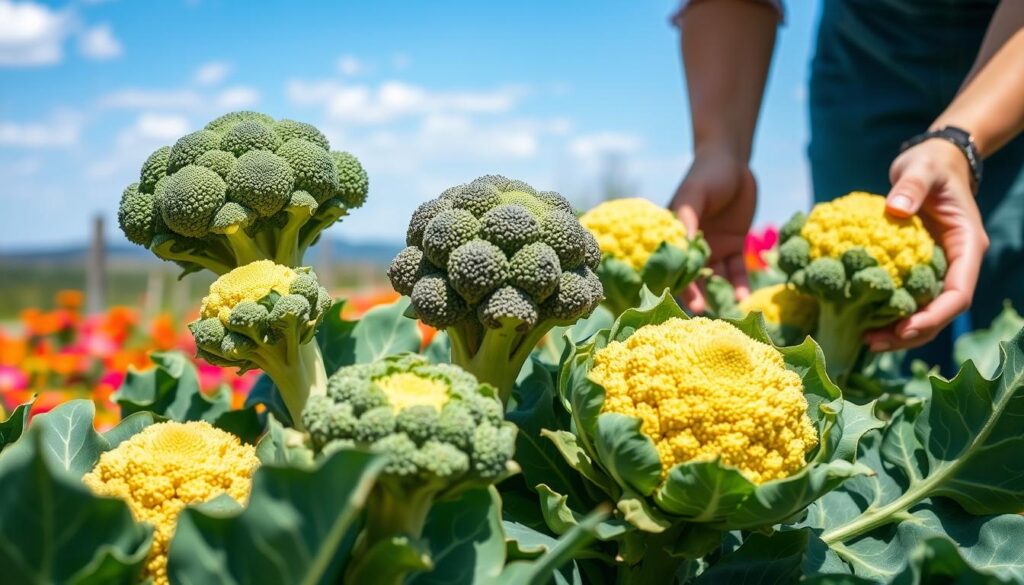
By following these tips and using a good guide, you’ll get a lot of broccoli. Always check the timing for the best taste and texture.
Storing and Preserving Your Broccoli Harvest
After growing broccoli at home, knowing how to store and preserve it is key. Proper methods keep your broccoli fresh and full of nutrients. It’s important to understand how to store and preserve broccoli well.
Here are some tips for storing and preserving broccoli:
- Refrigeration: Store broccoli in the refrigerator to keep it fresh for up to a week.
- Freezing: Blanch broccoli in boiling water, then cool and package it in airtight containers or freezer bags.
- Pickling: Soak broccoli in a brine solution, which can be stored in the refrigerator for several weeks.
By following thesebroccoli care instructions, you can enjoy your homegrown broccoli for a longer period. Always handle your broccoli gently to avoid bruising. Store it in a cool, dry place.
With these simple storage and preservation techniques, you can make the most of your broccoli harvest. Whether you’re a seasoned gardener or just starting out, proper storage and preservation are key. They help keep your broccoli fresh and flavorful.
| Storage Method | Duration | Instructions |
|---|---|---|
| Refrigeration | Up to 1 week | Store in airtight container |
| Freezing | Up to 6 months | Blanch, cool, and package in airtight containers or freezer bags |
| Pickling | Up to several weeks | Soak in brine solution and store in refrigerator |
Troubleshooting Common Growing Problems
Growing broccoli can sometimes face challenges, even with the best care. Organic broccoli cultivation needs careful attention and quick problem-solving. Leaf discoloration is a common issue, often due to pests, diseases, or lack of nutrients.
To tackle leaf problems, following good broccoli care is key. This includes watching for pests and diseases and keeping soil nutrients balanced. Organic methods like compost and natural fertilizers help a lot.
Leaf Issues and Solutions
- Check for pests like aphids and whiteflies, and treat with neem oil or insecticidal soap
- Inspect for diseases like downy mildew and powdery mildew, and treat with copper-based fungicides
- Test soil nutrient levels and adjust as necessary to prevent deficiencies
Head Formation Problems
Issues with broccoli heads can stem from too little water, extreme weather, or not enough sunlight. To fix this, make sure to water consistently and give broccoli full sun.
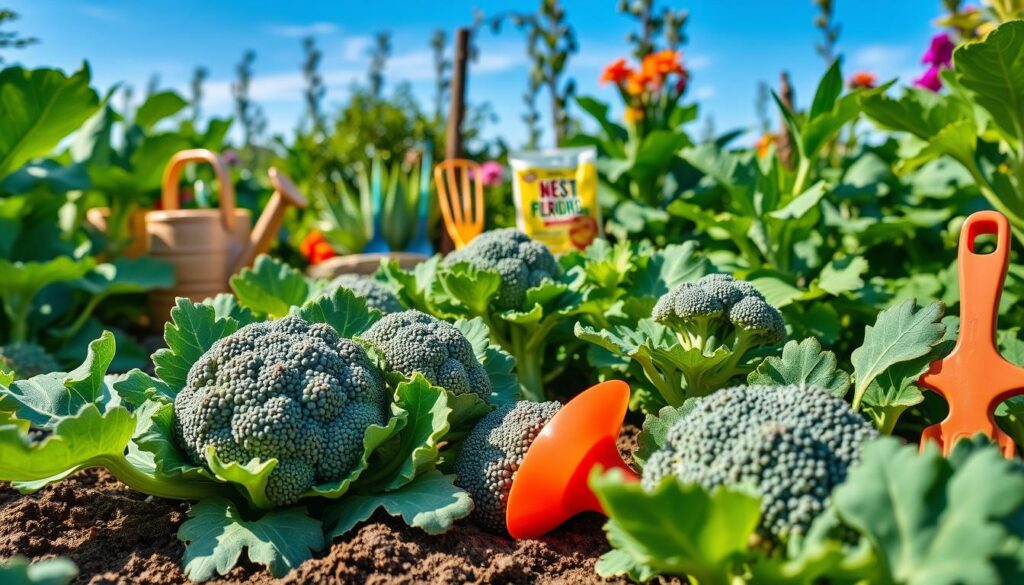
Environmental Stress Management
Stresses like frost, drought, or too much rain can be managed. Use row covers, irrigation systems, and soil amendments to help. With these tips, you can overcome common problems and have a great harvest from your organic broccoli.
| Problem | Solution |
|---|---|
| Leaf discoloration | Check for pests, diseases, and nutrient deficiencies |
| Head formation issues | Adjust growing conditions for optimal moisture, temperature, and light |
| Environmental stresses | Use row covers, irrigation systems, and soil amendments |
Conclusion: Your Path to Successful Broccoli Growing
Growing broccoli can be very rewarding. It gives you a tasty and healthy crop right in your garden. By following the broccoli growing guide, you’re on your way to a great harvest. Choose the right broccoli varieties for your area, prepare the soil well, and care for your plants.
With time and effort, you’ll enjoy the broccoli you’ve grown. It’s fulfilling to grow your own food. Plus, broccoli is full of nutrients and great for cooking. So, get ready to enjoy the broccoli you’ve grown.
FAQ
What are some popular broccoli cultivars?
Popular broccoli types include ‘Deep Purple’, ‘Waltham 29’, and ‘Packman’. Each variety has its own look, growth pattern, and how long it takes to mature.
What are the climate requirements for growing broccoli?
Broccoli likes cooler weather and does well in moist climates. It grows best in USDA hardiness zones 3-9.
What type of soil is best for growing broccoli?
Broccoli does well in soil that drains well and is rich in nutrients. The soil’s pH should be between 6.0 and 7.0. Adding compost or other organic matter can help.
When is the best time to plant broccoli in different regions?
Broccoli is a cool-season crop. It can be planted in spring or fall. For spring, start seeds indoors 4-6 weeks before the last frost. Then, move seedlings outside. For fall, sow seeds directly in the garden 8 weeks before the first frost.
What are the essential tools and materials needed for growing broccoli?
You’ll need high-quality broccoli seeds, potting soil that drains well, and organic fertilizers. Basic gardening tools like a trowel, watering can, and gloves are also necessary. You might also need containers, trellises, or row covers.
How do I grow broccoli from seeds to seedlings?
Start by sowing seeds indoors in seed trays or small pots. Keep the soil warm and moist until they germinate. Once they have 2-3 sets of leaves, move them to bigger pots or directly into the garden. Make sure they get enough light, water, and a bit of fertilizer. Before moving them outside, harden them off to get used to the outdoors.
How do I properly transplant broccoli seedlings?
Handle the roots gently when transplanting. Do it in the cooler part of the day. Keep the soil moist for a few days to help them adjust.
How much water and fertilizer do broccoli plants need?
Broccoli needs consistent moisture, more so when it’s young. As it grows, it needs about 1-2 inches of water per week. Use organic fertilizers like compost or fish emulsion to feed it. Follow a schedule to promote growth without overdoing it.
How do I manage pests and diseases in my broccoli garden?
Common pests include aphids, cabbage worms, and flea beetles. Use neem oil, row covers, and hand-picking to control them. Diseases like club root and downy mildew can be prevented by keeping the soil healthy, ensuring good air circulation, and choosing resistant varieties.
What are some good companion plants for broccoli?
Good companions for broccoli include herbs like basil and dill, and vegetables like carrots and beets. Avoid planting other Brassica family members or plants that shade or compete with broccoli.
When is the best time to harvest broccoli, and how do I properly cut the heads?
Harvest broccoli when the buds are tight and green, and the crown is firm. Cut the main head with a sharp knife, leaving a bit of stem attached. This encourages side shoots to grow, which can be picked continuously.
How can I store and preserve my broccoli harvest?
Store broccoli in the fridge for up to a week. For longer storage, freeze or pickle it. To freeze, blanch in boiling water, then cool and package in airtight containers or bags. Pickling involves soaking in a brine solution, which can be stored in the fridge for weeks.
What are some common growing problems with broccoli, and how can I solve them?
Common broccoli issues include leaf discoloration, poor head formation, and environmental stress. Leaf problems can be fixed with pest and disease management. Head issues might be due to moisture, temperature, or light. Environmental stress like frost, drought, or rain can be managed with row covers, irrigation, and soil amendments.
Share this post: on Twitter on Facebook

